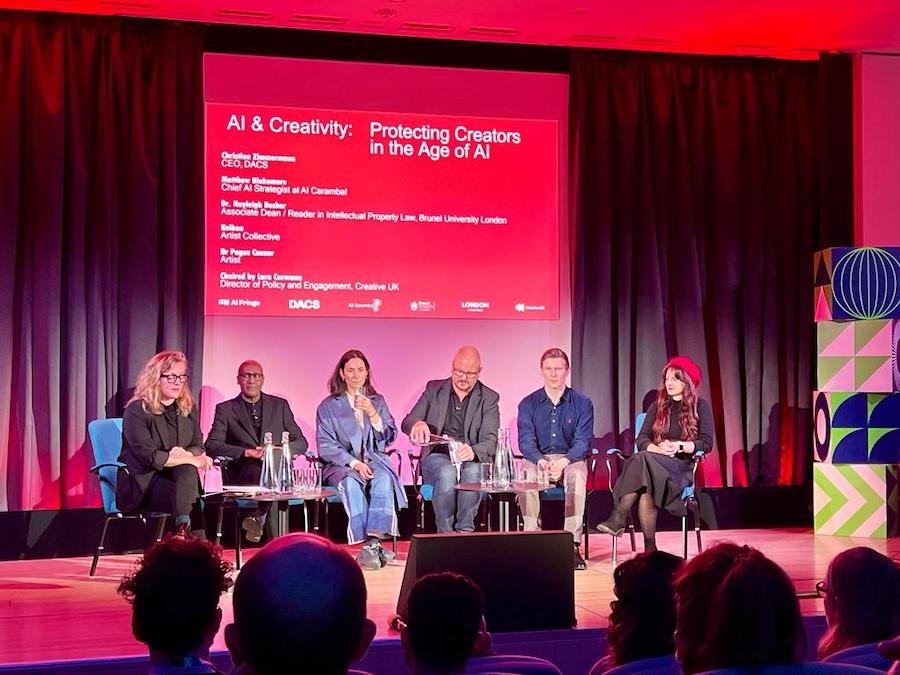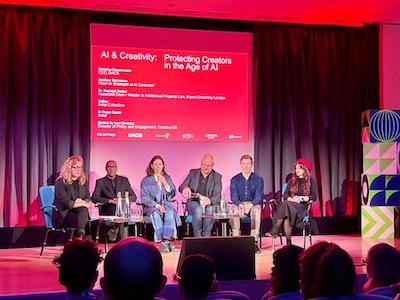

PAN reader, Steve Bergson, attended the AI & Creativity: Protecting Creators in the Age of AI, event at The British Library, London, Fri 3 Nov 23 – Here is his report for us.
AI & Creativity: Protecting Creators in the Age of AI, The British Library, London, Fri 3 Nov 23
To coincide with the UK AI Summit at Bletchley Park convened by the UK government, AI Fringe organised a panel discussion held near the local epicentre of UK cyberspace development (with Google Deep Mind just a digitally composited stone’s throw away), followed by a chat among artists with a diverse involvement with AI. The panel was chaired by Lara Carmona, director of Policy and Engagement at Creative UK and featured celebrated photographer Dr Pogus Caesar and DACS CEO Christian Zimmermann.
The discussion centred – almost inevitably – on the twin faces of AI’s potential, the positive and negative, literally poles apart. There is of course the parallel with photography which was not originally regarded as an art form but almost two centuries later, today’s challenge about what we value in artistic creation is even more far reaching. The degree to which the element of motor skill or artisanship is pitted against or divisible from the creative imagination is a key question which the panel tried to address. Dr Hayleigh Bosher, a reader in IP Law at Brunel University brought a more down-to-earth perspective on artists like Grimes’ apparent willingness to write contracts on a platform like X to exercise a degree of control over her output. Bosher didn’t however, see the need for licensing discipline diminishing, no matter how innovative the creative business models become. And that’s the trouble: if artists are to be remunerated for their efforts enough to go on producing them, there has to be some kind of structure on which to hang the exciting possibilities of AI assisted artistic endeavour.
It was suggested that a trace on source inspiration for the new work could be found in the prompts that are put into an AI image engine like Midjourney, but efficient implementation is not easy to envisage. The business might have to be pushed to follow a code of conduct or best practice, but this is likely something that would need to be enforced, at least in principle, probably at the international level of a universal convention. Even AI Caramba!’s Chief AI Strategist, Matthew Blakemore agreed we are in a race with serious consequences if artists are not protected; Big Tech will certainly not be volunteering to be subject to such restrictions. Currently it’s not even transparent how the models on which the AI functions were trained or which sites were scraped to obtain the raw material. One intriguing sidelight on the striving to protect rights is the way machine-produced art currently has itself no copyright protection in law. This gives the corporate lawyers at the companies most likely to be deploying the tech, pause to think.
During the chat that followed, the panel looked closer at this issue of monetising creativity but the participants, filmmaker and AI Community founder, Justin Hackney, art director Molly Smitten-Downes and sci-fi author and director, Lawrence Essex also wanted to stress the democratisation the new systems bring, allowing everyone to make art. Essex repeated the mantra to encourage the wary: if you’re worried about creative tools, you’re not very creative. This prompted an interesting discussion of the current attempts in software to trick the scrapers but Hackney in particular, was nevertheless keen to convey his sense that AI has the potential to make us all more human again, freeing us from the keyboard. We should embrace that.
The overall feeling from both valuable sessions was that as long as we don’t lose the craft and artistry – and leave the machines simply to churn out new versions of ‘Fast and Furious’ – the role of the creative is definitely empowered by all these epic tools, enabling us to tell stories in different ways. However, the niggling question remains: is this enhanced creativity only possible with a worrying price tag, the death of copyright?
Find Steve on his LinkedIn profile ….his new website should be ready shortly.
Thanks Steve!











